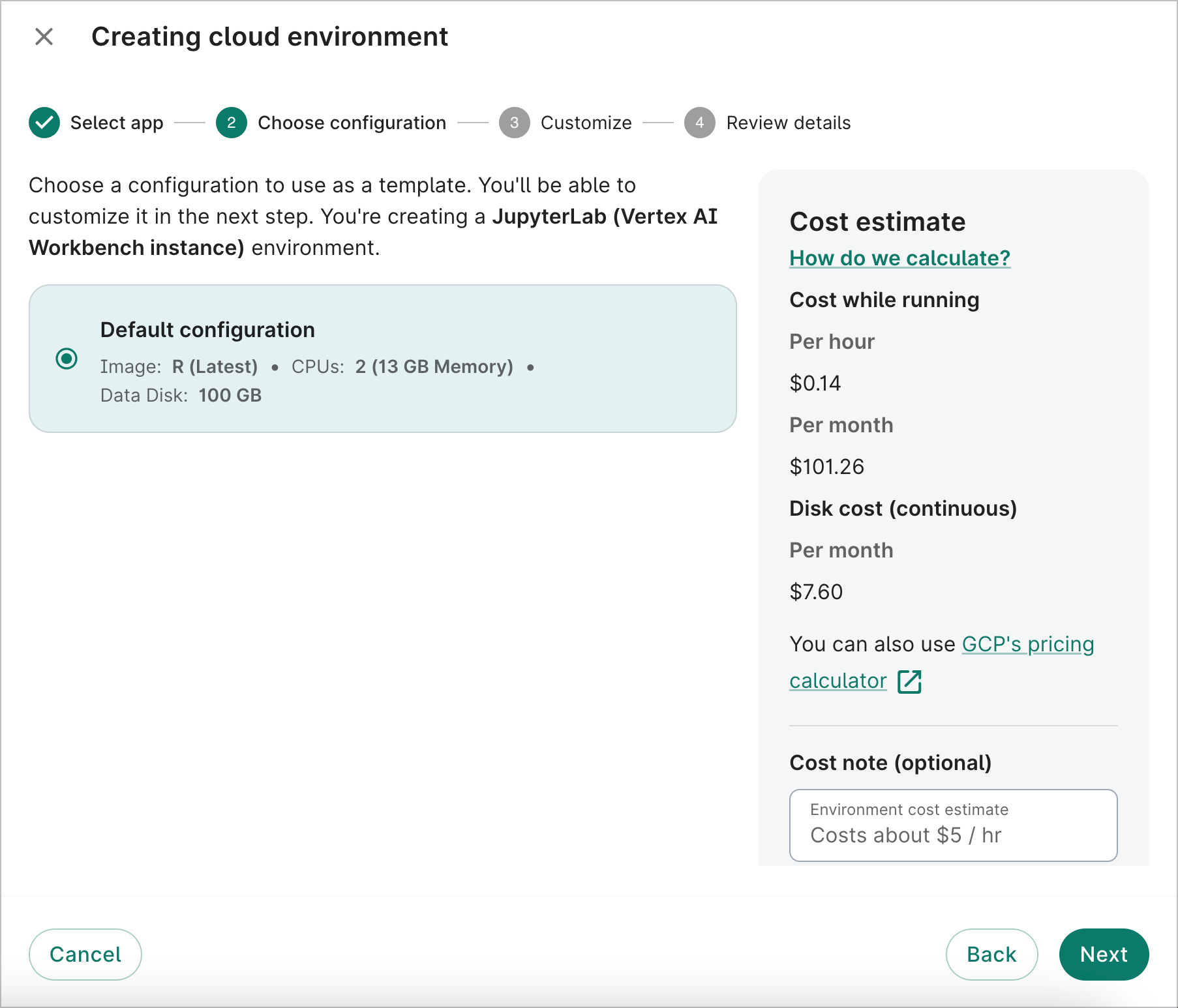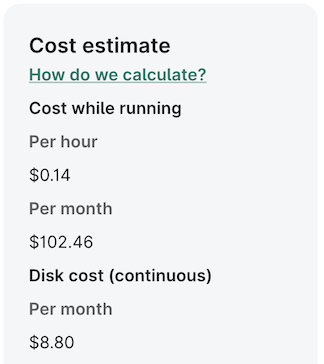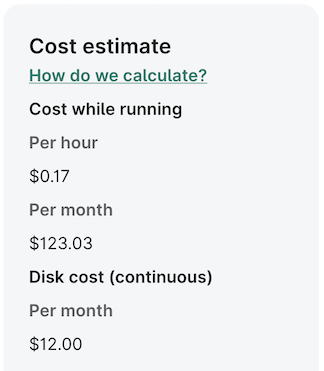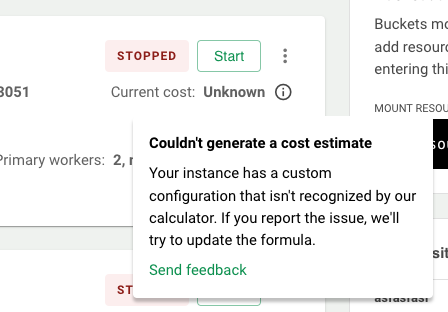Cloud app cost estimates
Categories:
Prior reading: Cloud apps overview
Purpose: This document provides details on how cloud app cost estimates are calculated.
Introduction
Verily Workbench dynamically generates cost estimates for your new and existing cloud apps.
You can find the cost estimates for your existing apps on each app card:

To view the cost estimates for a new app, create a new app and proceed to the Choose configuration step. You'll see the cost estimate for the default configuration.

Proceed to the Compute options step to configure the app image type, cloud compute profile, and autostop time length (if available). The cost estimate will dynamically change based on the number of CPUs and GPUs selected.
Note
Autostop is a feature available for all app types except JupyterLab Spark cluster. You can have your app automatically stop running after a specified idle time, anywhere from 1 hour to 14 days. By setting autostop, you can potentially save on compute costs by not having your app unnecessarily run. The idle time length can be edited at any time.Cost estimations on Google Cloud
Google Cloud cost estimations are internally computed directly from the pricing SKUs listed from the Cloud Billing API. This means that calculated costs reflect the on-demand pricing of cloud resources and does not factor in billing account-specific discounts including committed use discounts and negotiated pricing contracts.
There are several broad cost categories for apps on Google Cloud. These include compute costs, disk costs, network costs, and managed services fees. For detailed information on these costs, see Cost management on Google Cloud.
Workbench apps on Google Cloud are based on Compute Engine instances. Cost estimations depend on the following factors:
- Cloud compute profile
- Workspace region
- Managed service fees
Cloud compute profile
The number of CPUs and GPUs and the amount of memory all incur cost when the app is running.
Compute
For Vertex AI notebooks and custom applications,
you can set compute configurations directly in the UI. If you're creating an app using the
CLI, you can configure the
machine type
via the
--machine-type option. The machine type determines the number of CPUs and the amount
of memory configured for each node. For example,
the n2-standard-4 machine type is configured with 4 vCPUs and 16 GB of memory.
Note
To learn more about Compute Engine machine types, see Machine families resource and comparison guide. Apps incur vCPU and memory costs when they are running.For Dataproc clusters, you can configure the machine type for the master and worker nodes. The machine type determines the number of CPUs and the amount of memory for each node.
If a worker node is configured as a spot instance, then a spot discount is applied.
Disk
Persistent disks attached to apps also incur cost based on the disk size and disk type. For more information, see persistent disk pricing. Note that persistent disks incur cost even when the app is stopped.
By default, Vertex AI and custom application apps are configured with two standard persistent disks: a 150 GB boot disk and a 100 GB data disk.
For Dataproc clusters, persistent disks are attached and provisioned per VM, so two disks are provisioned for the master node and each worker node.
Note
For Vertex AI and Compute Engine apps, you can change the data disk size via the UI at the time of app creation.
The number of disks, disk type, and disk size can be changed via the CLI after you've created an app.
Region
The workspace default region determines the region-specific pricing of the compute profile and disk costs.
For example, the cost of a Vertex AI app created in us-west2 can
cost almost 20% more than the same notebook created in us-central1.


Managed service fees
Vertex AI and Dataproc cluster apps incur additional managed service fees. Google Cloud adds a fixed cost per CPU core. For more information, see Management in "Cloud cost management."
Unaccounted costs and discounts
Discounts
Cost estimates are calculated from the hourly on-demand pricing of individual cloud resource SKUs. Billing account-specific pricing including committed use discounts and negotiated contract pricing is not accounted for. Further, sustained use discounts accrued from running VMs for an extended duration of time are not accounted for. For more information on committed use discounts, see Resource-based committed use discounts. For more information on sustained use discounts, see Sustained use discounts for Compute Engine.
Networking Costs
Cost incurred from user actions such as copying or transferring data across cloud regions are not factored into cost estimations. This includes the estimated hourly and monthly costs displayed during app creation and the hourly cost displayed on each app card. See Networking costs for more information on data copying, download, and transfer costs.
Troubleshooting
You will see an Unknown cost estimate on the app card if an app
was created using the Workbench CLI (command-line interface) with an unsupported configuration for cost estimation.
You can submit feedback in
this
form to request cost estimation support for your app
configuration.

Last Modified: 11 December 2024